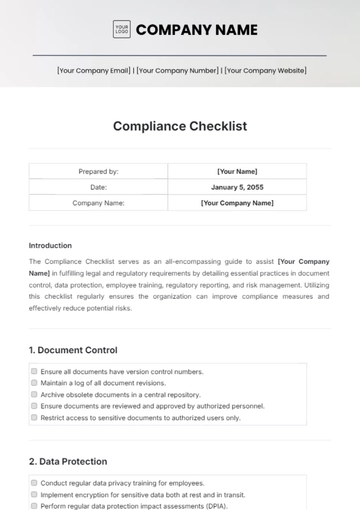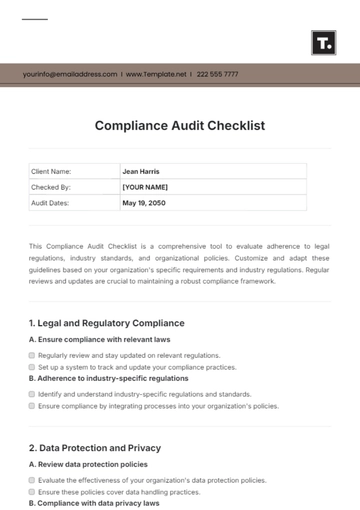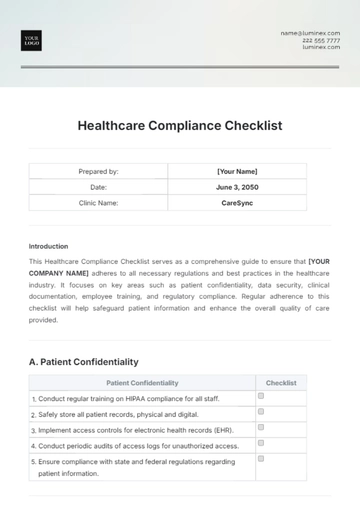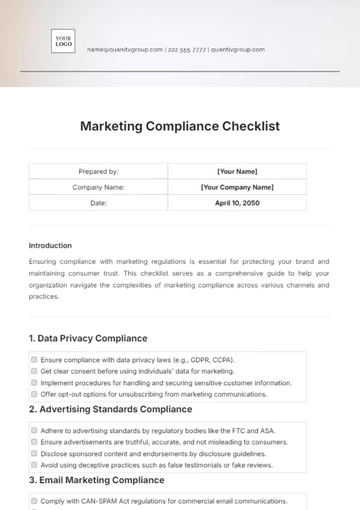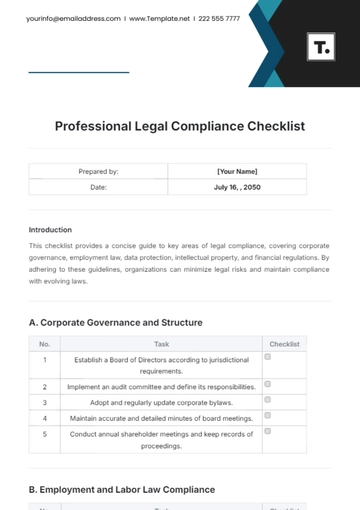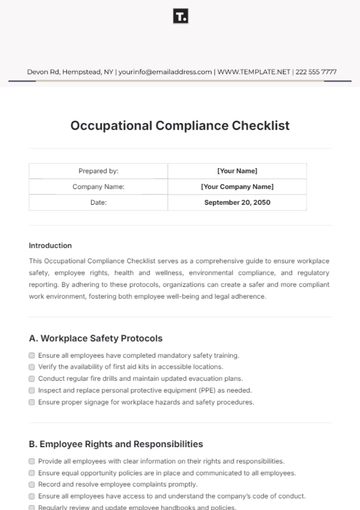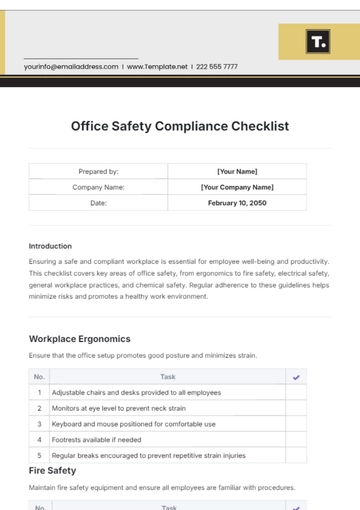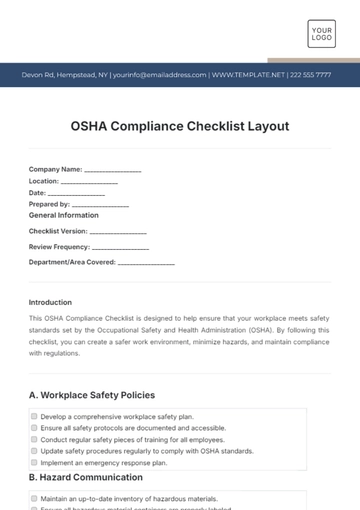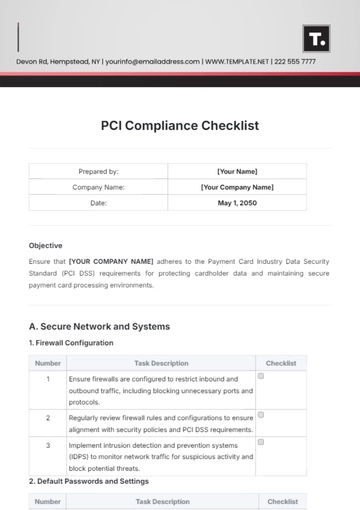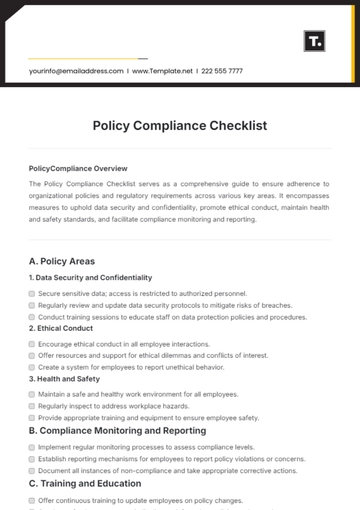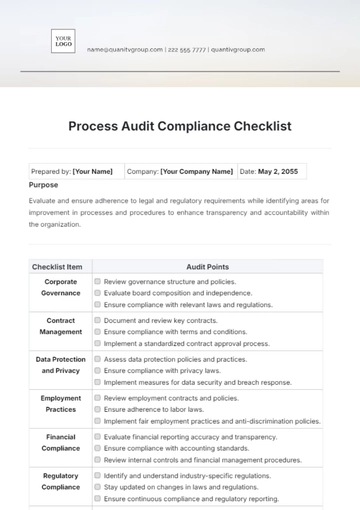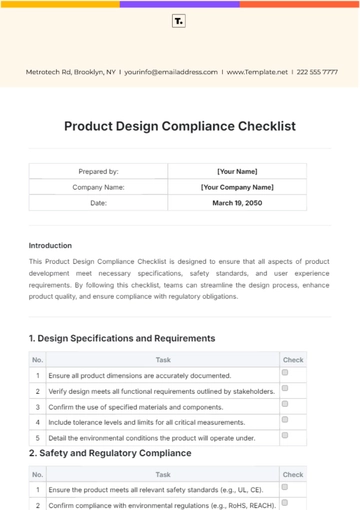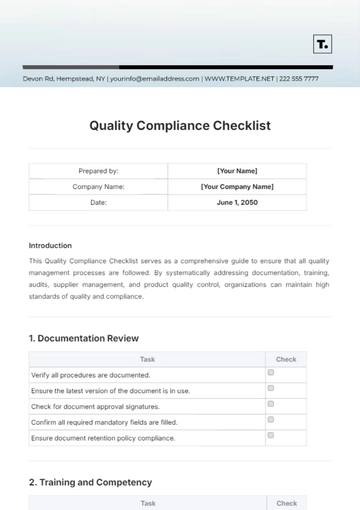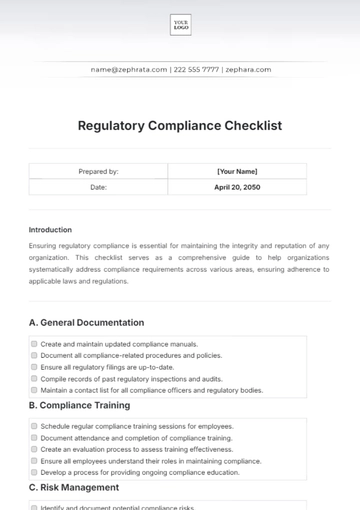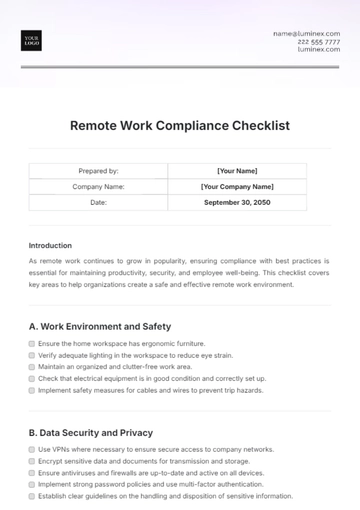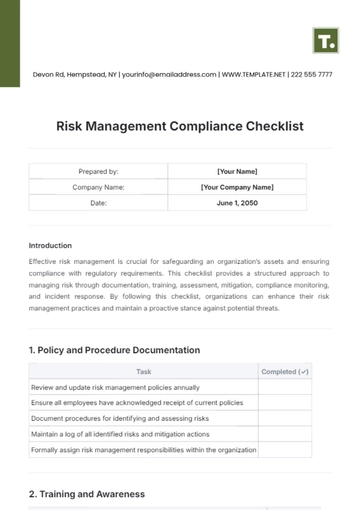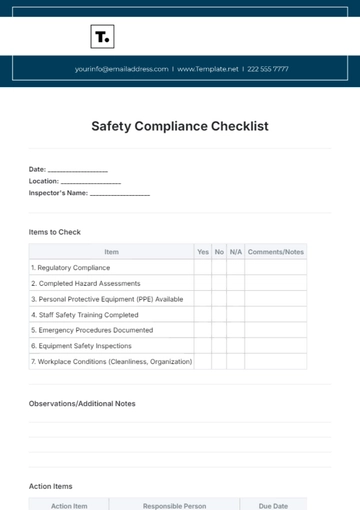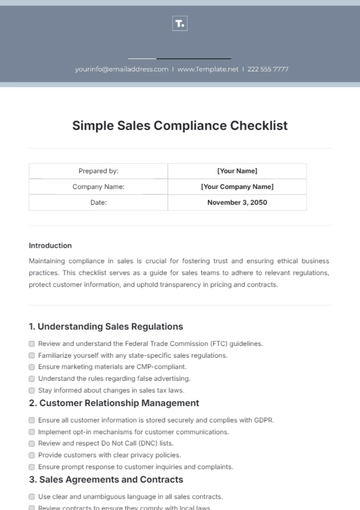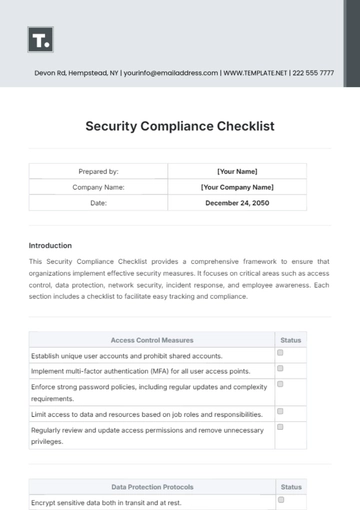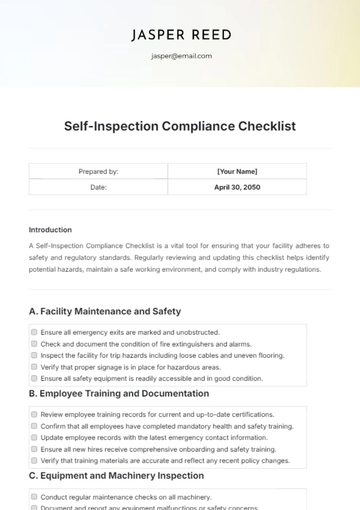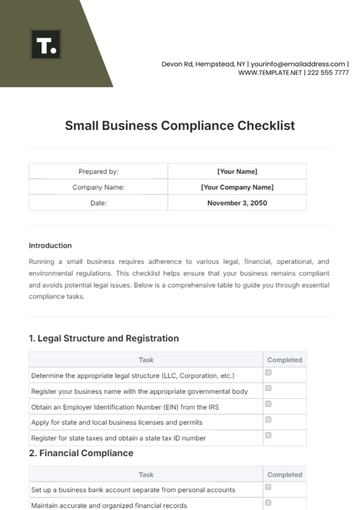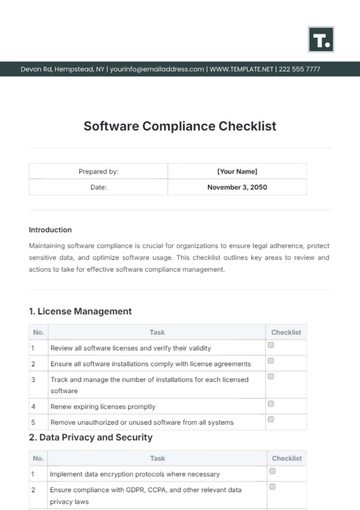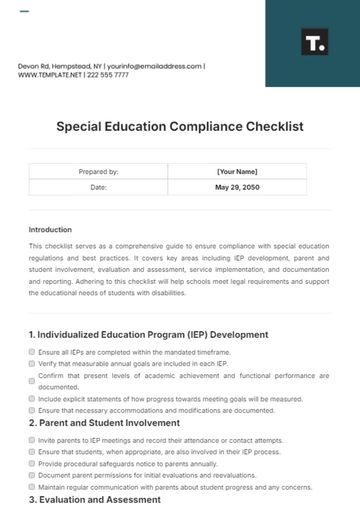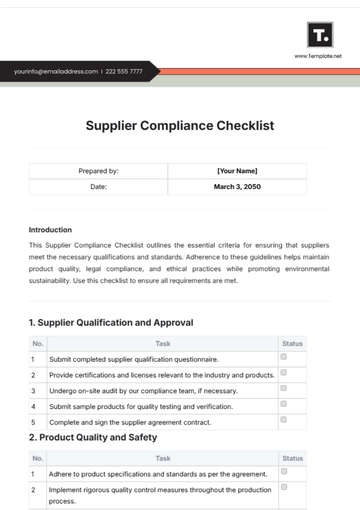Free EHS Compliance Checklist
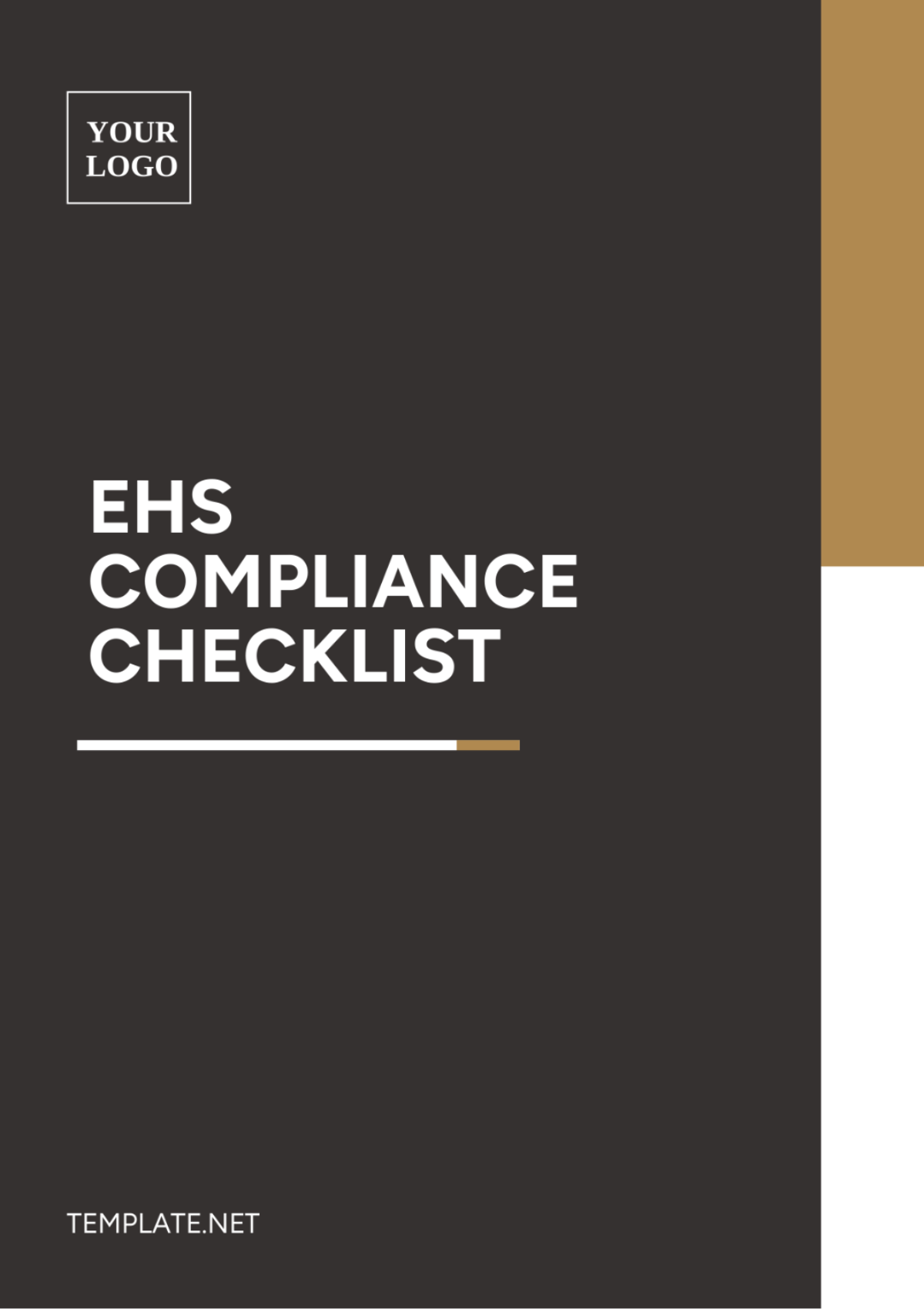
I. Compliance Overview
Objective: Ensure that [YOUR COMPANY NAME] adheres to Environmental, Health, and Safety (EHS) regulations and practices to maintain a safe and healthy work environment and minimize environmental impact.
Responsible Party: [YOUR NAME], EHS Compliance Officer
Date of Last Review: [DATE]
Next Scheduled Review: [NEXT REVIEW DATE]
II. Environmental Compliance
Regulatory Permits:
Identify and obtain all necessary environmental permits for business operations.
Ensure permits are up to date and renewed as required.
Include permits for air quality, water quality, and hazardous waste management.
Maintain records of permits and related documentation.
Pollution Prevention:
Implement pollution control technologies to reduce emissions and effluents.
Develop spill prevention plans and train employees on spill response procedures.
Initiate waste reduction initiatives to minimize environmental impact.
Regularly inspect and maintain pollution prevention measures.
Environmental Reporting:
Compile emissions data and submit reports to regulatory authorities.
Monitor discharge points and provide accurate data for discharge monitoring reports.
Prepare hazardous waste manifests and submit them in accordance with regulations.
Ensure all environmental reports are submitted on time and contain accurate information.
III. Health and Safety Compliance
Occupational Health and Safety (OHS) Programs:
Develop OHS programs to identify and mitigate workplace hazards.
Include hazard communication protocols, PPE requirements, and emergency response plans.
Implement measures to prevent workplace injuries and illnesses.
Regularly review and update OHS programs to address evolving hazards and regulations.
Employee Training:
Provide comprehensive OHS training to all employees.
Cover procedures for safe work practices and hazard recognition.
Ensure training on proper use of PPE and emergency response protocols.
Offer refresher courses and ongoing education to reinforce safety awareness.
Workplace Inspections:
Conduct regular inspections of the workplace environment.
Identify hazards and assess compliance with safety regulations.
Document inspection findings and implement corrective actions.
Involve employees in the inspection process to enhance hazard identification and promote a safety culture.
IV. Emergency Preparedness
Emergency Response Plans:
Develop comprehensive emergency response plans for various workplace emergencies.
Include procedures for fires, chemical spills, natural disasters, and medical emergencies.
Assign responsibilities and establish communication protocols during emergencies.
Review and update emergency response plans regularly to reflect changes in operations and regulations.
Emergency Equipment and Training:
Provide necessary emergency response equipment throughout the workplace.
Ensure availability of fire extinguishers, first aid kits, and emergency eyewash stations.
Train employees on proper use of emergency equipment and procedures.
Conduct refresher training sessions periodically to reinforce skills and knowledge.
Evacuation Drills:
Schedule regular evacuation drills according to regulatory requirements.
Simulate various emergency scenarios to test different aspects of the evacuation plan.
Evaluate employee response and identify areas for improvement.
Provide feedback and debriefing sessions after drills to discuss strengths and areas needing improvement.
V. Waste Management
Hazardous Waste Handling:
Ensure proper labelling of hazardous wastes.
Store hazardous wastes in designated areas with appropriate containment measures.
Dispose of hazardous wastes in compliance with hazardous waste regulations.
Maintain records of hazardous waste generation, storage, and disposal.
Recycling and Waste Reduction:
Implement recycling programs for materials like paper, plastics, glass, and metals.
Promote waste reduction initiatives such as source reduction and product reuse.
Educate employees on proper waste sorting and recycling practices.
Monitor waste generation and track progress towards waste reduction goals.
Spill Prevention and Response:
Develop spill prevention plans tailored to the specific hazards present in the workplace.
Conduct regular inspections to identify potential spill risks and implement corrective actions.
Provide spill response training to employees, including proper use of spill containment materials and cleanup procedures.
Maintain spill response kits stocked with appropriate materials and equipment.
Document spill incidents, response actions taken, and lessons learned for future improvement.
VI. Employee Health and Wellness
Health Promotion Programs:
Establish health promotion initiatives to encourage employee wellness.
Offer wellness incentives such as gym memberships or healthy eating subsidies.
Conduct health screenings for employees to identify health risks and promote early intervention.
Provide access to health resources and services, such as counseling, vaccination programs, and fitness classes.
Evaluate the effectiveness of health promotion programs through employee feedback and participation metrics.
Ergonomics:
Conduct ergonomic assessments to identify potential hazards in the workplace.
Implement ergonomic solutions to reduce the risk of musculoskeletal disorders.
Train employees on proper ergonomic practices, including workstation setup and ergonomic equipment use.
Incorporate ergonomic design principles into the selection and layout of workstations and equipment.
Regularly review and update ergonomic policies and procedures to address changing workplace conditions and ergonomic best practices.
VII. Continuous Improvement
Performance Monitoring:
Track incident rates, including injuries, illnesses, and near misses.
Monitor regulatory citations and compliance status.
Measure environmental performance metrics such as waste generation, energy consumption, and emissions.
Analyze trends in KPIs to identify areas for improvement and prioritize corrective actions.
Management Review:
Schedule regular management reviews of EHS programs and performance.
Evaluate the effectiveness of EHS policies, procedures, and controls.
Identify strengths, weaknesses, opportunities, and threats related to EHS performance.
Allocate resources and support for implementing corrective actions and continuous improvement initiatives.
Document management review findings, decisions, and action plans for future reference and accountability.
VIII. Signature
By signing below, you acknowledge that you have reviewed and understand the contents of this EHS compliance checklist and affirm [YOUR COMPANY NAME]'s commitment to maintaining a safe, healthy, and environmentally responsible workplace.

EHS Compliance Officer
[YOUR COMPANY NAME]
Date: [DATE]
- 100% Customizable, free editor
- Access 1 Million+ Templates, photo’s & graphics
- Download or share as a template
- Click and replace photos, graphics, text, backgrounds
- Resize, crop, AI write & more
- Access advanced editor
Discover seamless compliance with the EHS Compliance Checklist Template from Template.net. Effortlessly tackle safety regulations with this editable and customizable tool, ensuring tailored solutions for your business needs. Edit with ease using our AI Editor Tool, empowering you to streamline your compliance processes effortlessly.
You may also like
- Cleaning Checklist
- Daily Checklist
- Travel Checklist
- Self Care Checklist
- Risk Assessment Checklist
- Onboarding Checklist
- Quality Checklist
- Compliance Checklist
- Audit Checklist
- Registry Checklist
- HR Checklist
- Restaurant Checklist
- Checklist Layout
- Creative Checklist
- Sales Checklist
- Construction Checklist
- Task Checklist
- Professional Checklist
- Hotel Checklist
- Employee Checklist
- Moving Checklist
- Marketing Checklist
- Accounting Checklist
- Camping Checklist
- Packing Checklist
- Real Estate Checklist
- Cleaning Checklist Service
- New Employee Checklist
- Food Checklist
- Home Inspection Checklist
- Advertising Checklist
- Event Checklist
- SEO Checklist
- Assessment Checklist
- Inspection Checklist
- Baby Registry Checklist
- Induction Checklist
- Employee Training Checklist
- Medical Checklist
- Safety Checklist
- Site Checklist
- Job Checklist
- Service Checklist
- Nanny Checklist
- Building Checklist
- Work Checklist
- Office Checklist
- Training Checklist
- Website Checklist
- IT and Software Checklist
- Performance Checklist
- Project Checklist
- Startup Checklist
- Education Checklist
- Home Checklist
- School Checklist
- Maintenance Checklist
- Planning Checklist
- Manager Checklist
- Wedding Checklist
- Vehicle Checklist
- Travel Agency Checklist
- Vehicle Inspection Checklist
- Interior Design Checklist
- Backpacking Checklist
- Business Checklist
- Legal Checklist
- Nursing Home Checklist
- Weekly Checklist
- Recruitment Checklist
- Salon Checklist
- Baby Checklist
- Equipment Checklist
- Trade Show Checklist
- Party Checklist
- Hospital Bag Checklist
- Evaluation Checklist
- Agency Checklist
- First Apartment Checklist
- Hiring Checklist
- Opening Checklist
- Small Business Checklist
- Rental Checklist
- College Dorm Checklist
- New Puppy Checklist
- University Checklist
- Building Maintenance Checklist
- Work From Home Checklist
- Student Checklist
- Application Checklist
